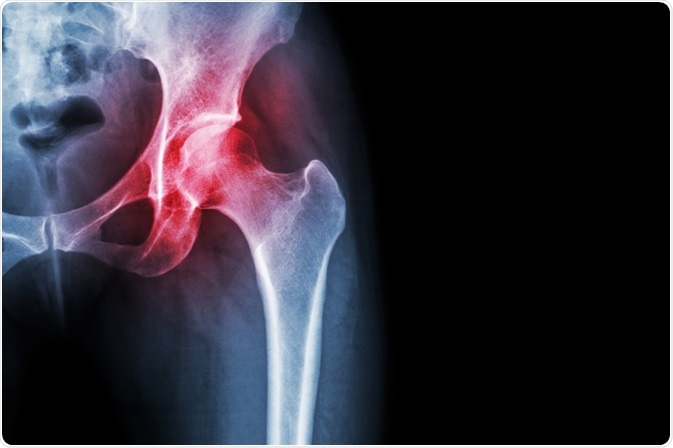Rheumatology is a broad discipline that covers the non-surgical management of disorders involving the musculoskeletal system. A myriad of different pathophysiological processes (such as abnormalities in biochemical pathways, degeneration, trauma, autoimmunity and inflammation) underpin the diseases of this system.
There are more than 200 specific rheumatic diseases known today which span from various types of arthritis to osteoporosis, and on to systemic connective tissue diseases. Among the first disorders to be defined were rheumatoid arthritis, gout and osteoarthritis.

Image Credit: Puwadol Jaturawutthichai / Shutterstock
Rheumatoid arthritis
Rheumatoid arthritis represents a common autoimmune disorder associated with progressive disability, potential systemic complications, early death, and concomitant socioeconomic costs. It has been reported that this disease affects up to 1% of the adult population of developed regions around the world.
Akin to many autoimmune diseases, the etiology of rheumatoid arthritis is multifactorial. The disease is characterized by inflammatory pathways and the overproduction of proinflammatory cytokines that cause the proliferation of synovial cells in joints. Ensuing pannus formation often leads to underlying cartilage destruction and bony erosions.
Patients with this disease typically present with stiffness and pain in multiple joints. Commonly involved structures are wrists, as well as proximal interphalangeal and metacarpophalangeal joints. Patients often present with morning stiffness and systemic symptoms of fatigue, low-grade fever and weight loss. Increased mortality is due to accelerated cardiovascular disease, particularly in patients with high disease activity and chronic inflammation.
Gout
Gout is a specific type of inflammatory arthritis triggered by the deposition of monosodium urate crystals in synovial fluid and other tissues. This rheumatologic condition is often associated with hyperuricemia, serious comorbidity and increased risk of cardiovascular disease. The definitive diagnosis of gout demands microscopic identification of monosodium urate crystals.
Two clinical phases of gout are commonly observed. Intermittent acute gout is one of the most painful forms of arthritis, characterized by the abrupt onset of severe joint pain (classically the first metatarsophalangeal joint), swelling and erythema, with asymptomatic periods between attacks. If hyperuricemia is not treated satisfactorily, transition to the second phase which manifests as chronic tophaceous gout can ensue.
Recognized triggers for recurrent flares are alcohol intake, diuretic use, hospitalization and surgery. The patient should understand that sugar-sweetened drinks and a large amount of meat or seafood may contribute to elevated urate levels, therefore such episodes should be minimized. Management should be tailored to the stage of disease and eventual coexisting illnesses.
Other diseases
Systemic lupus erythematosus (SLE) represents a chronic and potentially debilitating autoimmune inflammatory disease that is commonly encountered in women of childbearing age. Although any organ system can be affected, clinical symptoms are usually musculoskeletal, dermatologic, renal and hematologic. The disease can be mild or life-threatening, depending on the organs involved.
Osteoarthritis is the most common chronic condition of the joints, with an associated risk of mobility disability for patients with affected knees being greater than that due to any other medical condition in people aged 65 years of age or older. The societal burden of this rheumatologic disorder is expected to increase as obesity level soars and the community becomes increasingly older.
The inflammatory myopathies represent a heterogeneous group of subacute, chronic or acute acquired diseases of striated muscle. On the basis of unique clinical, immunological, histopathological and demographic features, they are differentiated into three major subsets: dermatomyositis, polymyositis and inclusion body myositis.
Arthritis is also the most frequent, but least specific manifestation of rheumatic fever. Other diseases in rheumatology include spondyloarthropathies, Sjögren's syndrome, systemic sclerosis, various forms of vasculitis, and a plethora of congenital and familial disorders that affect different joints.
Further Reading
Last Updated: Feb 13, 2023